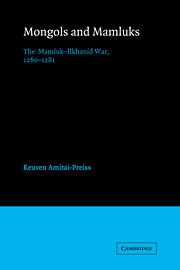Book contents
- Frontmatter
- Contents
- List of illustrations
- Preface
- List of abbreviations
- Notes on dates and transliteration
- Introduction
- 1 The historical background
- 2 The battle of ʿAyn Jālūt
- 3 The formulation of anti-Īlkhānid policy
- 4 The search for a second front
- 5 Military and diplomatic skirmishing
- 6 The secret war
- 7 Baybars's intervention in Seljuq Rūm
- 8 Baybars's posthumous victory: the second battle of Homs (680/1281)
- 9 The Mamluk–Īlkhānid frontier
- 10 Mamluks and Mongols: an overview
- Maps
- Genealogical Tables
- Glossary
- Bibliography
- Index
8 - Baybars's posthumous victory: the second battle of Homs (680/1281)
Published online by Cambridge University Press: 23 November 2009
- Frontmatter
- Contents
- List of illustrations
- Preface
- List of abbreviations
- Notes on dates and transliteration
- Introduction
- 1 The historical background
- 2 The battle of ʿAyn Jālūt
- 3 The formulation of anti-Īlkhānid policy
- 4 The search for a second front
- 5 Military and diplomatic skirmishing
- 6 The secret war
- 7 Baybars's intervention in Seljuq Rūm
- 8 Baybars's posthumous victory: the second battle of Homs (680/1281)
- 9 The Mamluk–Īlkhānid frontier
- 10 Mamluks and Mongols: an overview
- Maps
- Genealogical Tables
- Glossary
- Bibliography
- Index
Summary
Mengü Temür [brother of Abagha] was wounded at the battle [of Homs in AH 680], and he was greatly saddened for what had happened to him and his army, when he had been so close to victory.
Ibn al-FurātBaybars did not live to see the long-expected Mongol invasion of Syria, which led to the confrontation north of Homs in Rajab 680/October 1281. Professor Ayalon has written: “Though this battle was won by Ḳalāwūn, the real architect of the victory was undoubtedly Sultan Baybars, who, in the seventeen years of his rule … built a war-machine which, in spite of the decline it underwent during the four years following his death, proved to be strong enough to beat one of the mightiest armies which the Mongol Īlkhāns ever put into the field.”
The Mamluks after Baybars's death
The Mamluk-Īlkhānid front was relatively quiet in the first years after Baybars's death. The lack of an external danger meant that the Mamluk elite could indulge in factional squabbling and jockeying for power with relative impunity. When the Mongol threat again became a reality in 679/1280, the Mamluk factions were able, if not to reconcile their differences, at least to find a modus vivendi. Those members of the military society who persisted in plotting against Qalawun were eliminated.
Baybars's son al-Malik al-Saʿīd Berke Khan succeeded his father without any problems. Once on the throne, al-Saʿīd set about limiting the power of the Ṣāliḥī amirs, that is, his father's khushdāshiyya, and other senior amirs, including those of the Ẓāhiriyya (the mamluks of Baybars).
- Type
- Chapter
- Information
- Mongols and MamluksThe Mamluk-Ilkhanid War, 1260–1281, pp. 179 - 201Publisher: Cambridge University PressPrint publication year: 1995

